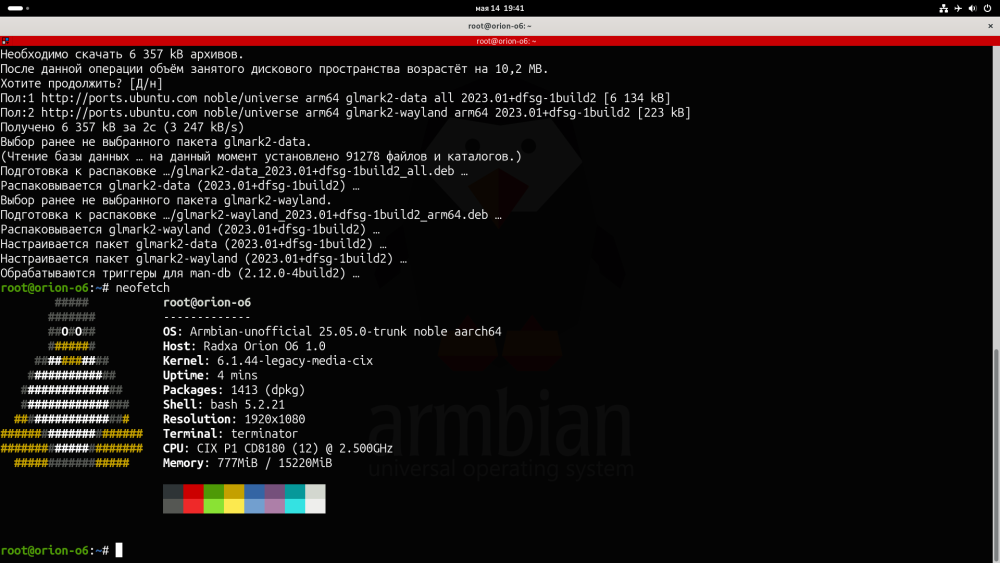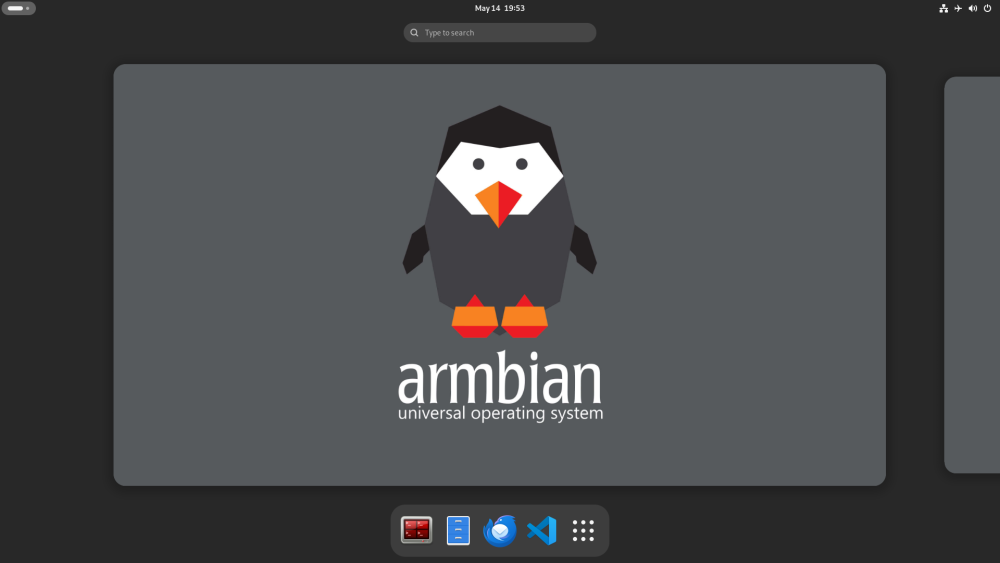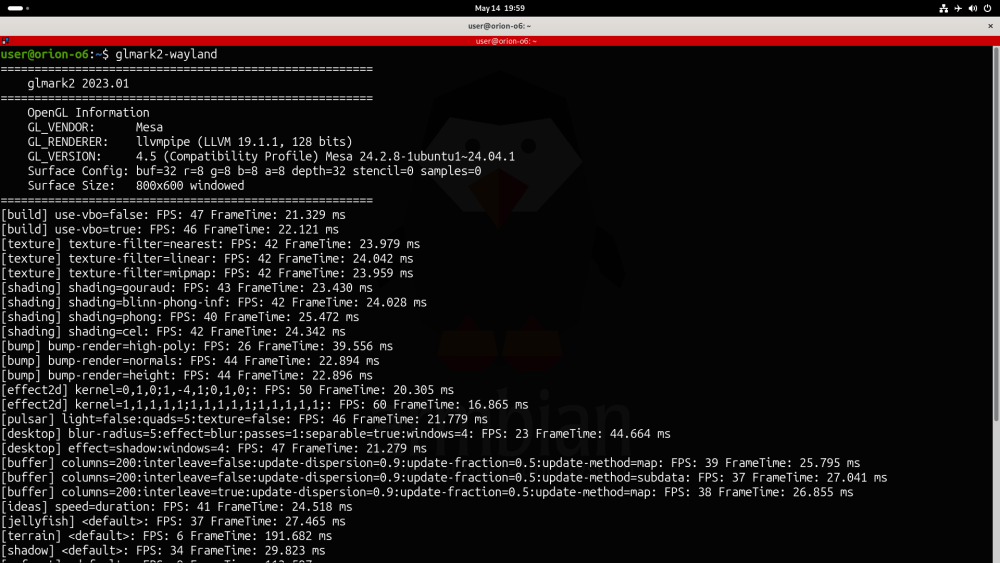All Activity
- Past hour
-

can't find debian package tags
Jacob Burckhardt replied to Jacob Burckhardt's topic in Software, Applications, Userspace
My Armbian user space is Ubuntu. I don't see tags on a non-Armbian Ubuntu host either, so maybe the issue is not caused by Armbian but is more related to Ubuntu vs Debian differences. Thanks. - Today
-
There are big differences between the two revisions. The biggest one is, one is using Wifi/BT over USB and the other SDIO, which requires the sdio overlay. The reason for BT not working on Armbian, I have yet to figure out. Like I said before, it works on (my personal) a more minimal build; Debian GNU/Linux trixie/sid 6.12.26 #1 Sun May 4 17:50:23 EDT 2025 aarch64 BananaPi BPI-M4-Zero v2 ── DISK Filesystem Size Used Avail Use% Mounted on /dev/mmcblk2p2 29G 2.8G 26G 10% / /dev/mmcblk2p1 466M 74M 363M 17% /boot ── NETWORK Hostname: bananapim4zero Wireless: wlan0 UP 10.0.0.XX Bluetooth: hci0 AC:6A:A3:3B:D9:D6 ── SYSTEM Processor: Cortex-A53 @ 1416MHz 52°C Frequency: 1416MHz Online: 0-3 Governor: performance Memory: 3.8G 199M Entropy: 256 Uptime: 15:13:05 up 4 min, 1 user, load average: 0.01, 0.06, 0. It is hard for me to determine the reasons BT doesn't work, as the patching is very extensive. If it is even the patching? And yes I include the BT node in the overlay; https://github.com/armbian/build/blob/main/patch/kernel/archive/sunxi-6.12/patches.armbian/Add-BananaPi-BPI-M4-Zero-overlays.patch#L267 As for HDMI audio and GPU, the PR I posted a link to corrects this. In future releases and rolling (give it a day) it should now work. Although I think I need to now add my changes to the 6.14.y branch? I'll check.
-
Many thanks @c0rnelius but I need clarifications. I agree that for standard build, using overlays (bananapi-m4-sdio-wifi-bt and sun50i-h616-gpu build), wifi (with or without antenna) and GPU are ok, but it is not true for rolling release 570 suggested by @going , and I never got HDMI sound (no sound cards each time). Are you refering to another recent build? If HDMI sound is also available it’s great! And what about bluetooth? When you write wireless do you include bluetooth? Denis
-
It only works when you are already logged in Gnome, just for your session (no sudo). If you want global settings, you could try setting this via /etc/profile.d/. Create a script like: /etc/profile.d/disable-screen-blank.sh With the contents #!/bin/bash if [ "$XDG_SESSION_TYPE" = "wayland" ]; then gsettings set org.gnome.desktop.session idle-delay 0 fi and make it executable sudo chmod +x /etc/profile.d/disable-screen-blank.sh I tried it and it works for my Gnome 48 test system.
-
The alpha version of Armbian images for Orion O6 is available. To launch, burn to a USB flash drive, connect to Orion O6 and turn on the power (installation on NVMe has not yet been verified). The system starts automatically. Important. Image output to the monitor works only in graphical mode (in images with DE). Console output currently only works in UART, so you need a UART console or SSH connection for initial startup. Launching the desktop and displaying the image on the screen can take 30-80 seconds, depending on the speed of the media. https://disk.yandex.ru/d/gedMM0eLiURrjA Armbian-unofficial 25.05.0-trunk Noble ttyAMA2 orion-o6 login: root Password: _ _ _ __ __ _ _ _ /_\ _ _ _ __ | |__(_)__ _ _ _ ___ _ _ _ _ ___ / _|/ _(_)__(_)__ _| | / _ \| '_| ' \| '_ \ / _` | ' \___| || | ' \/ _ \ _| _| / _| / _` | | /_/ \_\_| |_|_|_|_.__/_\__,_|_||_| \_,_|_||_\___/_| |_| |_\__|_\__,_|_| v25.05 rolling for Orion O6 running Armbian Linux 6.1.44-legacy-media-cix Packages: Ubuntu stable (noble) Support: DIY (custom image) IPv4: (LAN) 192.168.1.47 (WAN) 185.213.138.150 Performance: Load: 21% Up time: 0 min Memory usage: 4% of 14.86G CPU temp: 32°C Usage of /: 40% of 14G storage/: 1% of 253M RX today: 6 MiB Commands: Configuration : armbian-config Monitoring : htop root@orion-o6:~# Disk /dev/ram14: 40 MiB, 41943040 bytes, 81920 sectors Units: sectors of 1 * 512 = 512 bytes Sector size (logical/physical): 512 bytes / 4096 bytes I/O size (minimum/optimal): 4096 bytes / 4096 bytes Disk /dev/ram15: 40 MiB, 41943040 bytes, 81920 sectors Units: sectors of 1 * 512 = 512 bytes Sector size (logical/physical): 512 bytes / 4096 bytes I/O size (minimum/optimal): 4096 bytes / 4096 bytes Disk /dev/nvme0n1: 238.47 GiB, 256060514304 bytes, 500118192 sectors Disk model: MTFDHBA256TCK-1AS1AABHA Units: sectors of 1 * 512 = 512 bytes Sector size (logical/physical): 512 bytes / 512 bytes I/O size (minimum/optimal): 512 bytes / 512 bytes Disklabel type: gpt Disk identifier: E146202C-4719-46E5-B98F-3B8E899D01FD Device Start End Sectors Size Type /dev/nvme0n1p1 2048 206847 204800 100M EFI System /dev/nvme0n1p2 206848 239615 32768 16M Microsoft reserved /dev/nvme0n1p3 239616 499049968 498810353 237.9G Microsoft basic data /dev/nvme0n1p4 499050496 500115455 1064960 520M Windows recovery environment Disk /dev/sda: 14.32 GiB, 15376000000 bytes, 30031250 sectors Disk model: Ultra Fit Units: sectors of 1 * 512 = 512 bytes Sector size (logical/physical): 512 bytes / 512 bytes I/O size (minimum/optimal): 512 bytes / 512 bytes Disklabel type: gpt Disk identifier: AC0DE29F-BE91-413F-B3A6-7A9DF368C41D Device Start End Sectors Size Type /dev/sda1 8192 532479 524288 256M EFI System /dev/sda2 532480 30031216 29498737 14.1G Linux root (ARM-64) Disk /dev/zram0: 7.43 GiB, 7979745280 bytes, 1948180 sectors Units: sectors of 1 * 4096 = 4096 bytes Sector size (logical/physical): 4096 bytes / 4096 bytes I/O size (minimum/optimal): 4096 bytes / 4096 bytes
-

Lost wifi after upgrade on latest bookworm/noble images
Paul Damian replied to SeanTheITGuy's topic in BIGTREETECH CB1
Thank you. It seems the issue persists also on "v25.2.3 for BigTreeTech CB1 running Armbian Linux 6.12.20-current-sunxi64" -

Target Packages [...] is configured multiple times on fresh install
laibsch replied to Paul Damian's topic in BIGTREETECH CB1
/etc/apt/sources.list:1 and /etc/apt/sources.list.d/debian.sources:1 Those are the files and lines that are duplicate that apt tells you about -
@ScoreABSM Should fix part of the problem; https://github.com/armbian/build/pull/8191 As for Wifi, it works fine for me. Make sure you have an antenna attached or it may not find anything on the network to connect to. As one user already discovered;
-

Target Packages [...] is configured multiple times on fresh install
Werner replied to Paul Damian's topic in BIGTREETECH CB1
Hi, its just a warning. Check the files mentioned and remove duplicate lines. -
Fresh install on the latest image (Armbian_25.2.2_Bigtreetech-cb1_bookworm_current_6.6.75_minimal.img.xz). First thing I wanted to do was an armbian-upgrade, but: Hit:1 http://deb.debian.org/debian bookworm InRelease Hit:2 http://deb.debian.org/debian bookworm-updates InRelease Hit:3 http://security.debian.org bookworm-security InRelease Hit:4 http://deb.debian.org/debian bookworm-backports InRelease Hit:5 https://github.armbian.com/configng stable InRelease Hit:6 https://netcup-02.armbian.com/beta bookworm InRelease Reading package lists... Done W: Target Packages (main/binary-arm64/Packages) is configured multiple times in /etc/apt/sources.list:1 and /etc/apt/sources.list.d/debian.sources:1 W: Target Packages (main/binary-all/Packages) is configured multiple times in /etc/apt/sources.list:1 and /etc/apt/sources.list.d/debian.sources:1 W: Target Packages (main/binary-arm64/Packages) is configured multiple times in /etc/apt/sources.list:1 and /etc/apt/sources.list.d/debian.sources:1 W: Target Packages (main/binary-all/Packages) is configured multiple times in /etc/apt/sources.list:1 and /etc/apt/sources.list.d/debian.sources:1 Any ideas? I'm a Linux noob, by the way 🙂 armbianmonitor -u file: https://paste.armbian.com/axolituped
-

RK3588 - Setting Up Mali & Hardware Acceleration
David N replied to David N's topic in Orange Pi 5 Plus
Thanks for the help! Switching to that kernel was enough to allow me to turn on transcoding after I mounted the proper /dev stuff to the docker container. Before I did this, transcoding just immediately crashed. Now I can see it working and it also looks to be using alot mess CPU as well, showing it's using the hardware. -

RK3588 - Setting Up Mali & Hardware Acceleration
Werner replied to David N's topic in Orange Pi 5 Plus
I don't think so. You can check in /boot/armbianEnv.txt if there is panthor overlay enabled. If so, disable it so you can use the proprietary mali blobs. -

How to reset the armbian system and restore the initial configuration operation??
IBV replied to lay's topic in Khadas EDGE2
Hi, not sure if there's a way to do this, I would re-flash the SD card with the image you were using. That will re-trigger the initial config. -

RK3588 - Setting Up Mali & Hardware Acceleration
David N replied to David N's topic in Orange Pi 5 Plus
Thanks for the response! For the kernel switch, is it using armbian-config to pick under my current installation? linux-image-vendor-rk35xx=25.2.3 v6.1.99 Is there anything else I need to do as well? Thanks! -

make driver patch - lib/module without full .img?
awef replied to awef's topic in Advanced users - Development
Thank you SteeMan and Werner. I will try out your recommendations. -

question about accuracy of onboard temperature sensor (BPi M2+)
laibsch replied to laibsch's topic in Allwinner sunxi
... but at the same time, others with H3-based boards seem to have similarly high idle temps reported. @Domas Do you own one of those infrared themometers or have another way to ascertain the true temperature of your board? As the title of this thread says, I am curious about the accuracy of the onboard sensors. Maybe the sensors are even accurate but they need proper software calibration.- 4 replies
-
- Banana Pi
- Banana Pi BPi-M2+
- (and 4 more)
-
unsupported host os for build environment. Grant the user access to Docker or use a Noble host.
-
split into new topic. Use one of the curl commands mentioned in your logs go upload full logs to a paste server. These will contain more information to debug this.
-

Stuck on jammy, can't upgrade to noble
Domas replied to Domas's topic in Software, Applications, Userspace
I understand this now. So autoinstalled flag does not cover base packages out of the box. I assumed that manually installed is something i have installed explicitly (as per apt install XXXX). Apparently autoinstalled is the flag that means "I was installed as a dependency only, please wipe me out whenever nothing depends on me" -

Stuck on jammy, can't upgrade to noble
laibsch replied to Domas's topic in Software, Applications, Userspace
Imagine you have package A and it depends on package B. "sudo apt install A B" will install both packages (this might happen during the image build process for the Armbian project). Now you remove package A, package B is no longer needed but is kept around nonetheless because it is not marked as automatically installed. Or imagine package A depends on libB-1 in focal. You upgrade to jammy but something got stuck half-way and somehow libB-1 dropped its mark of being auto-installed (apt does this sometimes to prevent problems). Now the new version of package A in jammy depends on libB-2 and you have both libB-1 and libB-2 installed. Often, this will not be a problem, but let's say you also have package C which conflicts with libB-1. Now you are starting to be in trouble because how is apt to know if you should keep C over libB-1? apt is pretty smart and often makes the right decision, but I am sure you can see how it may not. That is where you are at. They are not obsolete but no longer required AKA explicitly installed or a dependency of one such package. When you mark a package as automatically installed but it is in fact providing something you want (a font, a background image, a function, ...) you will lose that if no other package depends on it and the package gets autoremoved.





